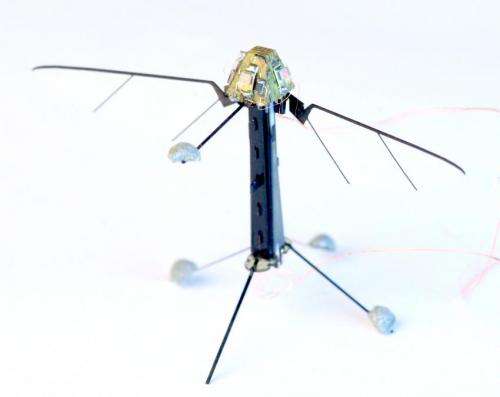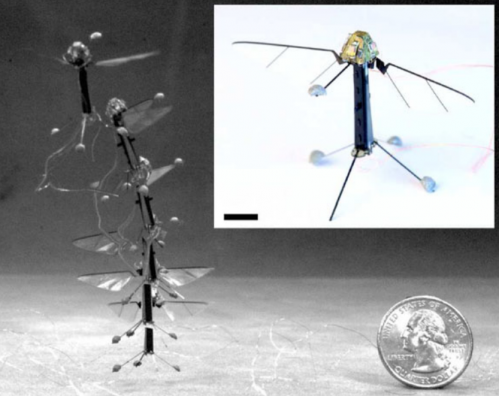Credit: The Royal Society
A combined team of researchers from Harvard and MIT has added a light sensor to a fly-sized drone to allow it to maintain stabilization and is the first known use of onboard sensors at such a small scale. In their paper published in Journal of the Royal Society Interface, the team describes how they copied the natural ocelli found on various insects to allow for stabilizing such a tiny drone, eliminating the need for external cameras.
Many insects, the casual observer will note, are masters of flight. They zoom around, darting and changing direction at a moment's notice, all while maintaining stability. How they do it is still only partially understood. Scientists do know that part of it has to do with ocelli found on the head of many insects—a set of three light sensors that are distinct from compound eyes. Prior research suggests they respond to the horizon, or perhaps light from the sun. In this effort, the researchers sought to create a hardware version of the ocelli and mount it on the head of a tiny (106mg) drone, which would use it to maintain an upright position as it flies. The result, a drone made mostly of carbon fiber, able to do just that, marking the first time a drone of such tiny size was able to do so without benefit of external cameras.
The light sensors were fashioned by soldering phototransistors on to a custom built circuit board that was then folded into a pyramid shape—the artificial ocelli was then connected to the top of the mosquito-looking drone. The drone was powered and controlled by an external source courtesy of a tether. And though test flights were short, less than half a second, the light sensors proved that the concept could work—it's possible to build tiny drones that can maintain their balance without resorting to cameras.
Such tiny drones could prove useful in disasters, zipping in and out of tiny spaces looking for survivors, or in other applications such as pollinating plants if bees continue to die off. Of course, that will only happen if new research results in a way to power and control such drones sans tether.
Credit: The Royal Society
More information: Controlling free flight of a robotic fly using an onboard vision sensor inspired by insect ocelli, Journal of the Royal Society Interface, Published 18 June 2014 DOI: 10.1098/rsif.2014.0281
Abstract
Scaling a flying robot down to the size of a fly or bee requires advances in manufacturing, sensing and control, and will provide insights into mechanisms used by their biological counterparts. Controlled flight at this scale has previously required external cameras to provide the feedback to regulate the continuous corrective manoeuvres necessary to keep the unstable robot from tumbling. One stabilization mechanism used by flying insects may be to sense the horizon or Sun using the ocelli, a set of three light sensors distinct from the compound eyes. Here, we present an ocelli-inspired visual sensor and use it to stabilize a fly-sized robot. We propose a feedback controller that applies torque in proportion to the angular velocity of the source of light estimated by the ocelli. We demonstrate theoretically and empirically that this is sufficient to stabilize the robot's upright orientation. This constitutes the first known use of onboard sensors at this scale. Dipteran flies use halteres to provide gyroscopic velocity feedback, but it is unknown how other insects such as honeybees stabilize flight without these sensory organs. Our results, using a vehicle of similar size and dynamics to the honeybee, suggest how the ocelli could serve this role.
Journal information: Journal of the Royal Society Interface
© 2014 Tech Xplore























